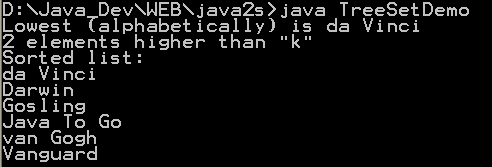Set operations
import java.util.LinkedHashSet;
import java.util.Set;
/**
* Note: This code is based on -<br>
* http://java.sun.com/docs/books/tutorial/collections/interfaces/set.html<br>
*
* Using LinkedHashSet, even though slightly slower than HashSet, in order to
* ensure order is always respected (i.e. if called with TreeSet or
* LinkedHashSet implementations).
*
* @author Ravi Mohan
* @author Ciaran O'Reilly
*/
public class SetOps {
/**
*
* @param <T>
* @param s1
* @param s2
* @return the union of s1 and s2. (The union of two sets is the set
* containing all of the elements contained in either set.)
*/
public static <T> Set<T> union(Set<T> s1, Set<T> s2) {
Set<T> union = new LinkedHashSet<T>(s1);
union.addAll(s2);
return union;
}
/**
*
* @param <T>
* @param s1
* @param s2
* @return the intersection of s1 and s2. (The intersection of two sets is
* the set containing only the elements common to both sets.)
*/
public static <T> Set<T> intersection(Set<T> s1, Set<T> s2) {
Set<T> intersection = new LinkedHashSet<T>(s1);
intersection.retainAll(s2);
return intersection;
}
/**
*
* @param <T>
* @param s1
* @param s2
* @return the (asymmetric) set difference of s1 and s2. (For example, the
* set difference of s1 minus s2 is the set containing all of the
* elements found in s1 but not in s2.)
*/
public static <T> Set<T> difference(Set<T> s1, Set<T> s2) {
Set<T> difference = new LinkedHashSet<T>(s1);
difference.removeAll(s2);
return difference;
}
}
Related examples in the same category
| 1. | Set, HashSet and TreeSet | | |
| 2. | Things you can do with Sets | |  |
| 3. | Set operations: union, intersection, difference, symmetric difference, is subset, is superset | | |
| 4. | Set implementation that use == instead of equals() | | |
| 5. | Set that compares object by identity rather than equality | | |
| 6. | Set union and intersection | | |
| 7. | Set with values iterated in insertion order. | | |
| 8. | Putting your own type in a Set | |  |
| 9. | Use set | |  |
| 10. | Another Set demo | | |
| 11. | Set subtraction | |  |
| 12. | Working with HashSet and TreeSet | |  |
| 13. | TreeSet Demo | |  |
| 14. | Show the union and intersection of two sets | | |
| 15. | Demonstrate the Set interface | | |
| 16. | Array Set extends AbstractSet | |  |
| 17. | Sync Test | | |
| 18. | Set Copy | | |
| 19. | Set and TreeSet | | |
| 20. | Tail | | |
| 21. | What you can do with a TreeSet | |  |
| 22. | Remove all elements from a set | | |
| 23. | Copy all the elements from set2 to set1 (set1 += set2), set1 becomes the union of set1 and set2 | | |
| 24. | Remove all the elements in set1 from set2 (set1 -= set2), set1 becomes the asymmetric difference of set1 and set2 | | |
| 25. | Get the intersection of set1 and set2, set1 becomes the intersection of set1 and set2 | | |
| 26. | Extend AbstractSet to Create Simple Set | | |
| 27. | Int Set | | |
| 28. | One Item Set | | |
| 29. | Small sets whose elements are known to be unique by construction | | |
| 30. | List Set implements Set | | |
| 31. | Converts a char array to a Set | | |
| 32. | Converts a string to a Set | | |
| 33. | Implements the Set interface, backed by a ConcurrentHashMap instance | | |
| 34. | An IdentitySet that uses reference-equality instead of object-equality | | |
| 35. | An implementation of the java.util.Stack based on an ArrayList instead of a Vector, so it is not synchronized to protect against multi-threaded access. | | |
| 36. | A thin wrapper around a List transforming it into a modifiable Set. | | |
| 37. | A thread-safe Set that manages canonical objects | | |
| 38. | This program uses a set to print all unique words in System.in | | |
| 39. | Indexed Set | | |
| 40. | An ObjectToSet provides a java.util.Map from arbitrary objects to objects of class java.util.Set. | | |
| 41. | Sorted Multi Set | | |
| 42. | Fixed Size Sorted Set | | |
| 43. | A NumberedSet is a generic container of Objects where each element is identified by an integer id. | | |
| 44. | Set which counts the number of times a values are added to it. | | |
| 45. | Set which counts the number of times a values are added to it and assigns them a unique positive index. | | |
| 46. | Indexed Set | | |
| 47. | A set acts like array. | | |
| 48. | Implements a Bloom filter. Which, as you may not know, is a space-efficient structure for storing a set. | | |
| 49. | Implementation of disjoint-set data structure | | |
| 50. | Call it an unordered list or a multiset, this collection is defined by oxymorons | | |